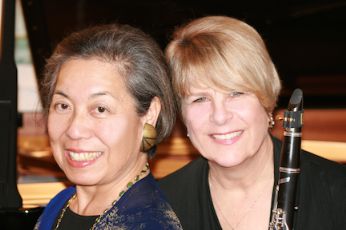|
Symphony
SRS SEASON ENDS WITH RESOUNDING TA-TA-TA-BANG
by Terry McNeill
Sunday, June 1, 2025
Symphony
YOUTHFUL VIRTUOSITY ON DISPLAY AT USO'S MAY CONCERTS
by Peter Lert
Saturday, May 17, 2025
Symphony
MYSTICAL PLANETS AND LIVELY GERSHWIN ORTIZ AT FINAL SRS CONCERT
by Peter Lert
Sunday, May 4, 2025
Symphony
VSO'S CONCERT MUSIC OF TIME, MUSIC OF PLACE
by Peter Lert
Sunday, April 27, 2025
Choral and Vocal
VOCAL ELEGANCE AND FIRE AT THE 222'S RECITAL APRIL 26
by Pamela Hicks Gailey
Saturday, April 26, 2025
CANTIAMO SONOMA SINGS AN INSPIRED GOOD FRIDAY MOZART REQUIEM CONCERT
by Pamela Hicks Gailey
Friday, April 18, 2025
DRAMATIC SHOSTAKOVICH SYMPHONY CLOSES PHILHARMONIC'S 25TH SEASON
by Terry McNeill
Sunday, April 13, 2025
LARGE COLLEGE OF MARIN AUDIENCE GREETS STOPHER ARTISTRY
by Terry McNeill
Saturday, April 5, 2025
Chamber
FRISSON DELIVERS SHIVERS OF DELIGHT
by Abby Wasserman
Sunday, March 30, 2025
OLD AND MOSTLY NEW IN SRS MARCH CONCERT IN WEILL
by Peter Lert
Saturday, March 22, 2025
|
 |
 LaDene Otsuki and Diane Maltester Nov. 9 in Vallejo |
CHAMBER MUSIC MASTERY IN VALLEJO SYMPHONY ORCHESTRA CONCERT
by Elizabeth Warnimont
Sunday, November 9, 2014
The Vallejo Symphony Orchestra presented the first small group performance of its 2014-2015 season Nov. 9 in the casual setting of Vallejo’s First Presbyterian Church. Clarinetist Diane Maltester wowed the audience with stunning performances of pieces by well-known and rarely heard composers.
“Diane and Friends,” the title of the concert, featured Ms. Maltester with pianist LaDene Otsuki and cellist Dawn Foster-Dodson. Beethoven’s B Flat Trio, Op. 11, was the opening work and Ms. Maltester’s instrument sang beautifully throughout. The Trio opens with an allegro movement in which cello and clarinet must speed through sprightly runs in sync with each other, while the piano contributes the soothing element of even, rhythmic accompaniment. The mood of the piece is lighthearted despite the virtuosic requirements it places on the musicians. Its succession of happy passages reminded me of a Buster Keaton silent film, lively and playful with few quiet interludes.
The second movement is Adagio, slowing things down enough for the composer to convey deeper emotions and allowing a more contemplative tone from both the wind and string instruments. Ms. Maltester's sensitive and masterful playing was all the more remarkable juxtaposed in these two contrasting movements.
The finale is a continuum of nine variations on the theme “Pria ch'io l'impegno” (Before I go to Work). The trio in its entirety is often referred to as the Gassenhauer, or “Street Song”, referring to the theme in this third movement that was commonly played by street musicians in Beethoven's time. Ms. Foster-Dodson’s sonorous cello was clearly heard in this part that included high-speed synchronized runs and expressive solo segments.
Weber’s brilliant Grand Duo Concertant, Opus 48, a showpiece for piano and clarinet, was a technical challenge for the performers, and Ms. Maltester played the emotional passages in the clarinet’s lowest register with a beautiful tone and apparent ease. The Duo also demands piano virtuosity and Ms. Otsuki’s playing kept pace with the sometimes lightning-fast runs.
The second movement is notably mournful at the onset, transitioning to more thoughtful passages before becoming more excited and hopeful at its height. The movement culminates in a somber and pessimistic tone, contrasting with the concluding Rondo movement in which piano and clarinet both sing happy tunes of revelry. As if to emphasize its happy ending, the piece concludes on a decisive final note, a tonal declaration of victory.
After a brief intermission, works by Bernstein and Muczynski were heard. The Bernstein's neoclassical Sonata for Clarinet and Piano, from 1943, has a modern feel with unusual and complex chord changes, rhythms and tonalities. The beginning Grazioso movement opens with tremendous discord, a sound of dizzying confusion and volume. Some bright melodic lines appear briefly, only to sink back into the mire of complex sound. The movement then transitions into music more palatable to most concertgoers. The following Andantino movement is dance-like in its relative grace and simplicity. The music is flirtatious and uncluttered, evocative of a contemporary dance performance. Passages of serene solitude interlace with more upbeat, celebratory strains. It was easy to hear the tenderness of sound from both the clarinet and the piano, especially in the upper registers. Ms. Otsuki’s playing was more aggressive here, exuding unfettered joy in the dancing piano passages.
The pianist’s playing was most persuasive in the Muczynski’s Op. 26 Fantasy Trio, beginning with the Allegro Energico. The composition shares the modern tone of the Bernstein piece but without the overly complex rhythms and dissonance. Ms. Otsuki's played beautifully expressive phrases in the sweet melodic segments, and the cello line also had a strong, pulsating ground beat and bright, violin-like melodies.
In the Andante movement the interactive melody and harmony that develops between cello and clarinet was striking, as if the two disparate sounds originated from one unified source. It was a sound of ethereal and pure beauty. In the finale (Allegro) Ms. Foster-Dodson played many dramatic runs and sharp staccato bursts. Themes from the earlier parts of the piece culminated here in a gala of sound. The higher-register melodies allowed Ms. Maltester to demonstrate another aspect of her mastery as she elicited flute-like sounds from her instrument.
As in the Weber Concertant, the Trio ends decisively with a clever play of changing meters and had an upbeat and celebratory character.
“Diane and Friends” was the final performance of the calendar year for the Vallejo Symphony, and the season continues with “Concert for the Animals” on January 25 in Vallejo’s Hogan Auditorium. The soloists will be pianists Eric Tran and Nathan Cheung with narrator Corey Fischer. David Ramadanoff is the conductor.
This review first appeared in the Benicia Herald.
|

